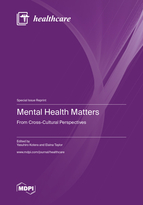Mental Health Matters: From Cross-Cultural Perspectives
A special issue of Healthcare (ISSN 2227-9032).
Deadline for manuscript submissions: closed (28 February 2023) | Viewed by 63136
Special Issue Editors
Interests: mental health; cross-culture; personal recovery; self-compassion
Special Issues, Collections and Topics in MDPI journals
Interests: mental health; individual differences and cross-cultural research; stress/stress-reduction; adjustment to long-term conditions; digital health interventions
Special Issue Information
Dear Colleagues,
Awareness of mental health has been increasing rapidly worldwide in recent years, and even more so since the outbreak of COVID-19. Depression is now regarded as one of the most debilitating diseases of all, and wellbeing is incorporated into the United Nation’s Sustainable Development Goals. In order for all of us to have a happy life, mental health cannot be ignored. As the UK government announced, our health cannot be achieved without good mental health. Likewise, turning to Asia, the word ‘health (健康)’ in Chinese and Japanese includes both a healthful body and a calm mind. The Japanese government implemented the work style reform to protect employees’ mental health. While these movements suggest the importance of mental health worldwide, a universal definition of mental health still remains to be defined. This is partly attributed to a lack of understanding of mental health from different cultures. How an individual regards mental health can be largely differ according to their culture. Accordingly, this Special Issue aims to address this problem by introducing alternative views to mental health through discussing cross-cultural psychiatric matters.
We are interested in various types of manuscripts, including original research, systematic reviews, reviews, mini-reviews, policy and practice reviews, perspectives, clinical trials, case reports, community case studies, brief research reports, and general commentaries.
Dr. Yasuhiro Kotera
Dr. Elaina Taylor
Guest Editors
Manuscript Submission Information
Manuscripts should be submitted online at www.mdpi.com by registering and logging in to this website. Once you are registered, click here to go to the submission form. Manuscripts can be submitted until the deadline. All submissions that pass pre-check are peer-reviewed. Accepted papers will be published continuously in the journal (as soon as accepted) and will be listed together on the special issue website. Research articles, review articles as well as short communications are invited. For planned papers, a title and short abstract (about 100 words) can be sent to the Editorial Office for announcement on this website.
Submitted manuscripts should not have been published previously, nor be under consideration for publication elsewhere (except conference proceedings papers). All manuscripts are thoroughly refereed through a single-blind peer-review process. A guide for authors and other relevant information for submission of manuscripts is available on the Instructions for Authors page. Healthcare is an international peer-reviewed open access semimonthly journal published by MDPI.
Please visit the Instructions for Authors page before submitting a manuscript. The Article Processing Charge (APC) for publication in this open access journal is 2700 CHF (Swiss Francs). Submitted papers should be well formatted and use good English. Authors may use MDPI's English editing service prior to publication or during author revisions.
Keywords
- mental health
- cross-culture
- psychiatry
- intervention
- compassion
- religion
- ikigai
- nature








